Picture a place where rain is rare, yet life is vibrant. That’s the desert, a world where about 1,750 out of nearly 1,950 cactus species live. These numbers show how desert plants are resilient and beautiful. I find it amazing how these plants can survive and even thrive in a place with little water.
Adding a cactus to your garden is a sustainable choice. It’s like bringing a piece of the desert into your yard. This brings life and beauty to a place that seems tough.
Cacti are more than their unique shapes and beautiful flowers. They are like nature’s sculptures that need little care but make a big impact. Whether you’re a pro at gardening or just love desert plants, adding these to your garden makes your space look better and helps the planet.
Key Takeaways
- There are over 1,750 cactus species enhancing desert landscapes.
- Cacti embody the ultimate form of dryland foliage, capable of surviving in arid conditions.
- Incorporating cacti into your garden promotes a low-water garden ideal for sustainability.
- Cactus plants add a unique visual element to any garden, echoing the beauty of harsh climates.
- A sustainable garden with cactus plants pays homage to the resilience of nature’s creations.
Understanding the Unique Beauty of Cactus Desert Plants
Cactus desert plants show off a special mix of beauty and function. They are made by nature to live and grow in tough places on Earth. These plants not only survive in harsh conditions but also add a unique look to any garden.
Nature’s Custom Design for Harsh Climates
Cactus desert plants are famous for living in extreme weather. They have thick stems to hold water and spines to protect them from the sun. These plants are not just survivors; they are living art shaped by nature over thousands of years.
Visual Appeal of Cactus Plants in Your Landscape
Adding visually striking cacti to your garden or landscape saves water and boosts your outdoor space’s beauty. They come in various shapes, sizes, and colors. This makes them perfect for creating a beautiful scene in your garden.
More people are choosing cactus desert plants for their gardens because they are easy to care for. These plants look unique and add a modern touch to gardens. They are great for modern garden designs.
| Cactus Type | Visual Characteristics | Ideal Climate |
|---|---|---|
| Saguaro | Tall, pillar-like structure with arms | Hot, arid |
| Prickly Pear | Broad, flat pads and vibrant flowers | Semi-arid to arid |
| Barrel Cactus | Short, round, stout shape with prominent ribs | Extreme arid |
In conclusion, cacti are more than just plants. They are living sculptures that show nature’s skill in creating life for tough environments. Let these visually striking cacti inspire your next landscape design project. They can turn any space into a beautiful garden.
Desert Plants: An Overview
When I started looking into desert plants, I was amazed by their variety and toughness. These plants have learned to live well in the desert ecosystem over thousands of years. They teach us a lot about living sustainably.
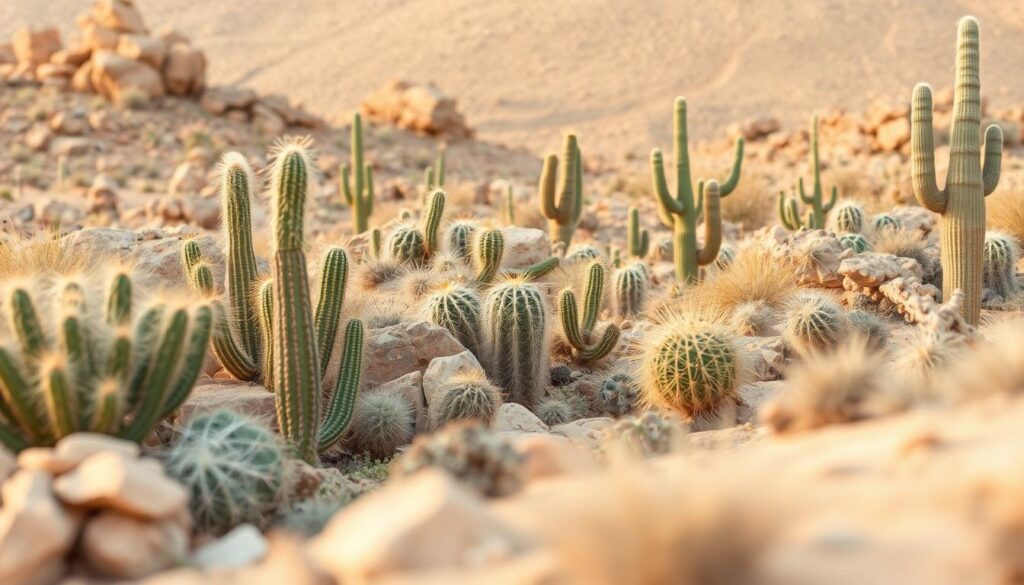
The desert is full of different plants, from the famous Saguaro cactus to the tough Joshua tree. Each one has found ways to survive with little water and high heat. They show us how to survive tough conditions.
- Saguaro Cactus: Majestic and towering, a water-storage expert.
- Ocotillo: Slim and spiky with leaves that appear only when moisture is available.
- Creosote Bush: Aromatic and robust, known for its effectiveness in desert soil stabilization.
Learning about these plants helps us understand the desert ecosystem better. It shows how different plants work together to survive. This teaches us about using resources wisely.
Studying drought-resistant flora reminds us of the power of adapting and being resilient. These traits are key as we deal with environmental changes. Each plant’s story encourages us to think differently about our environment.
The Importance of Drought-Tolerant Succulents
Drought-tolerant succulents are key to today’s gardens. They add beauty and variety to landscapes. They also help with sustainable gardening and water conservation.
Water Conservation with Low-Water Plants
In areas where water is scarce, choosing drought-tolerant succulents is smart. These plants need little water, which helps save local water resources. By picking these plants, gardeners can have beautiful gardens without using a lot of water.
The Role of Succulents in Sustainable Gardening
Sustainable gardening is about more than saving water. It’s about finding balance in nature. Succulents are great because they thrive in tough conditions. They need less care and help support local wildlife by providing homes.
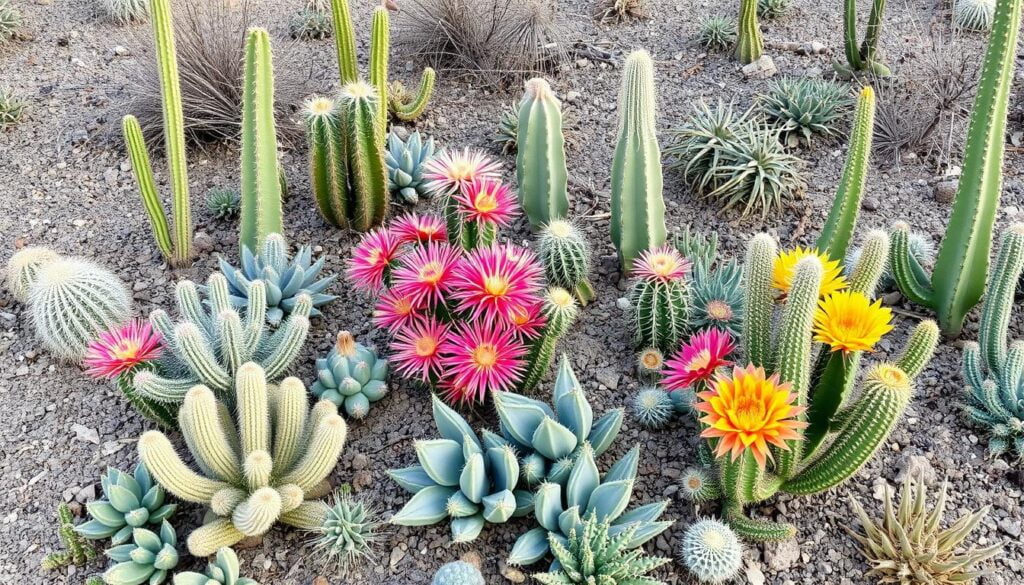
| Benefits | Example Plants | Water Savings |
|---|---|---|
| Low maintenance | Sedum, Sempervivum | Up to 70% less than traditional plants |
| Enhances biodiversity | Agave, Echeveria | Attracts diverse wildlife |
| Soil erosion prevention | Opuntia (Prickly Pear) | Excellent ground cover |
Choosing drought-tolerant succulents is a big step. It’s about caring for our planet. By using these plants, we help save water and support sustainable gardening. This makes our gardens better for the earth.
Different Types of Cactus Species in the Desert
Exploring the desert reveals a world of cactus species full of resilience and beauty. Each type has adapted uniquely to survive in tough environments. This shows the amazing variety and traits of these plants.
Identifying Common Cactus Families
Many common cactus families stand out in the desert with their unique features. The Cactaceae family includes most known cactus species. They are known for their thick stems that store water, crucial for survival in dry lands.
This family highlights the diversity and adaptability of these plants. They interest botanists and enthusiasts alike.
Characteristics that Define Various Cactus Species
The traits of cactus species are fascinating and crucial for their survival. Spines act as defense against animals and help reduce water loss by casting a shadow. The roots of cacti spread out to absorb water from short desert rains.

Knowing these traits is key for those interested in cacti. By understanding common cactus families and their traits, we can protect these amazing plants. This ensures they continue to thrive in their natural habitats for years to come.
Creating a Desert Oasis: Selecting the Right Cactus
Turning your backyard into a desert oasis begins with picking the right cacti. These plants must not only survive but also flourish in your area. It’s crucial to know how climate, soil, and sunlight affect them.
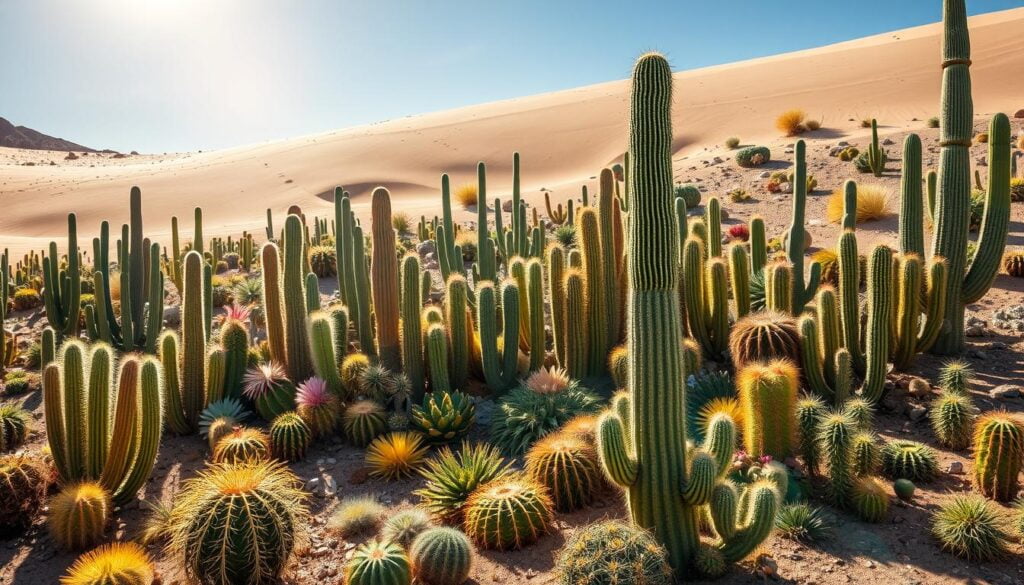
Creating a desert garden is more than just looking good. It’s also about being sustainable and easy to care for. Here’s what I look for when choosing the best cacti for any garden:
- Check how much sunlight your garden gets to pick the right cacti.
- Make sure the soil drains well; cacti don’t like wet roots.
- Think about how big the cactus will get to make sure it fits your space.
Choosing the right cacti turns your garden into a desert oasis. It becomes a peaceful place that celebrates nature’s toughest plants.
| Cactus Type | Sunlight Needs | Soil Type | Water Requirements |
|---|---|---|---|
| Saguaro | Full sun | Well-draining | Minimal |
| Prickly Pear | Full sun to partial shade | Sandy | Low |
| Barrel Cactus | Full sun | Rocky | Low to moderate |
For more tips on great plants for Los Angeles’ Mediterranean climate, check out this guide on choosing plants that thrive.
Your desert oasis’s success depends on picking and caring for the right cacti. By choosing cacti that fit your area and style, you make a garden that’s both beautiful and resilient.
Adapting to Arid Landscapes: How Cacti Thrive
Cacti are amazing survivors in dry places. They show us how nature can adapt and thrive in tough conditions. These plants have changed over time to live well in dry areas. Let’s look at how they do it.
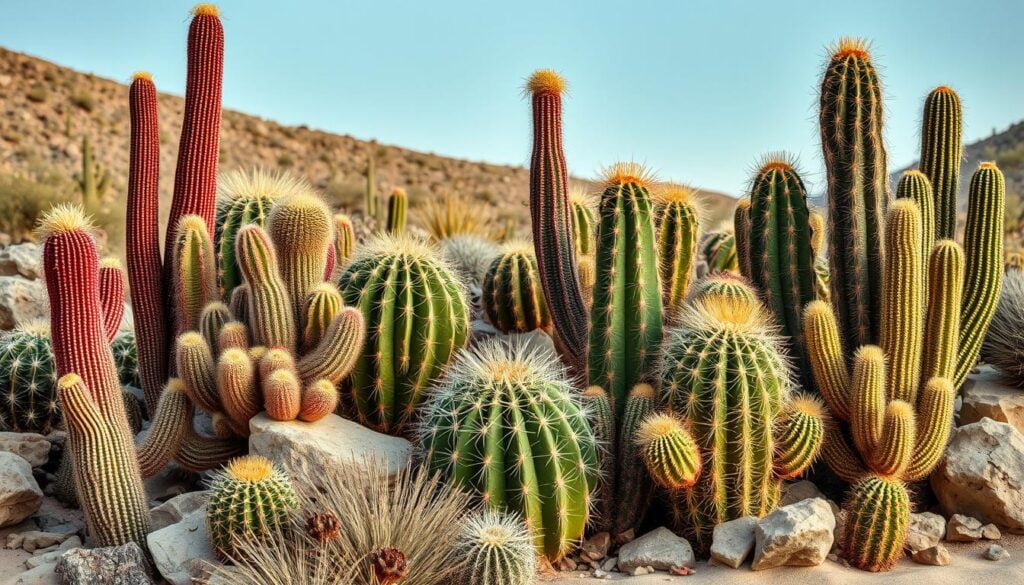
The Science Behind the Survival of Dryland Foliage
Cacti are special because they can live in very dry places. They have changed a lot to stay alive. They have small spines instead of leaves to lose less water. Their stems are thick and can store water, helping them during dry times.
Cacti’s Remarkable Water Retention Strategies
At a cellular level, cacti use a special way of making food called CAM photosynthesis. This lets them take in water at night to save it. They store CO2 and use it when the sun comes out. This way, they use their water and energy wisely. Their thick, waxy skin also helps keep water from escaping.
Learning about cacti shows us how life can survive in harsh places. It’s amazing to see how these plants fit perfectly into their dry environments. Walking through these areas, I’m always in awe of these incredible plants.
Indoor vs. Outdoor Cactus Gardens
Whether you’re in a cozy city spot or have a big yard, cacti can make your space special. Let’s dive into the world of indoor cactus gardens and outdoor cacti cultivation. I’ll give you tips on how to bring these tough plants into your life, making sure they thrive under your care.
Creating an Indoor Desert-Inspired Space
Creating a desert-inspired space inside can bring peace and beauty. When setting up an indoor cactus garden, think about the light. Cacti love lots of natural light, so place them near windows that get plenty of sun. Pick cacti like the Saguaro or Mammillaria for indoor life.
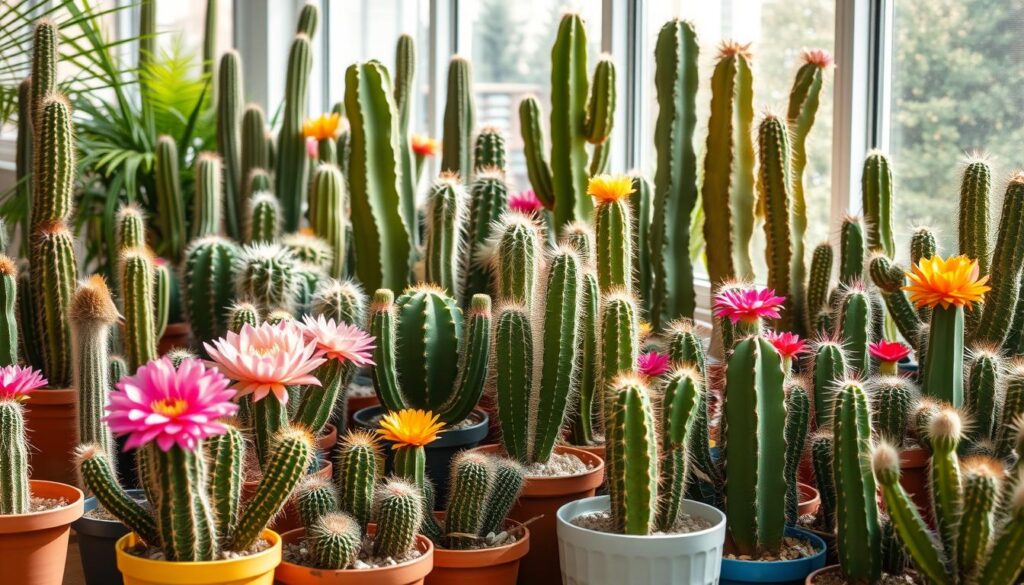
Tips for Cultivating Cacti Outdoors
If you like outdoor cacti cultivation, you’ll find many options. Outdoor gardens boost your home’s look and help the local ecosystem. Remember to choose a spot that feels like their desert home. This means a sunny, slightly raised area to keep water away from the roots during rainy times.
| Feature | Indoor Cacti | Outdoor Cacti |
|---|---|---|
| Light Requirements | Bright, indirect sunlight | Full sun |
| Watering Frequency | Every 3-4 weeks | Varies, more frequent in hot weather |
| Temperature Tolerance | Prefer stable indoor temperatures | Can withstand wider temperature ranges |
| Soil Type | Fast-draining cactus mix | Amended soil with good drainage |
Whether you’re an expert or just starting, both indoor cactus gardens and outdoor cacti cultivation are rewarding. They let you bring the desert’s beauty into your home or garden.
Iconic Cactus Desert Plants for Your Garden
Adding iconic cactus plants to your garden boosts its look and supports green gardening. These tough plants are great for making eye-catching gardens that need little water and care. Let’s look at some top cactus plants that can turn your garden into a lively and eco-friendly spot.
![]()
Saguaro Cactus (Carnegiea gigantea) – This cactus stands out with its classic arms. It’s a symbol of the Sonoran Desert and can be a stunning focal point in any garden.
Golden Barrel Cactus (Echinocactus grusonii) – Its round shape and golden-yellow spines make it a standout in any garden.
Prickly Pear Cactus (Opuntia) – With its wide, flat pads and bright flowers, this cactus brings color and texture to gardens.
- Low Water Requirement: Once they’re set, these cacti need little water, perfect for dry spots.
- Easy to Cultivate: Most iconic cactus plants are simple to grow and maintain, making them a breeze for gardeners.
- Spectacular Flowers: Despite looking tough, many cacti have beautiful flowers that draw in bees and hummingbirds.
Adding iconic cactus plants to your garden not only makes it look better but also helps with sustainable gardening. This is key in today’s eco-conscious world.
Unveiling Lesser-Known Cacti Varieties
Welcome to a fascinating journey into unique cacti varieties and rare cactus plants. These plants are often overlooked but are full of potential for gardeners at all levels. Let me introduce you to some of the most interesting species that can make your garden stand out.
Many people know about cacti like the giant Saguaro or the prickly pear. But there are many lesser-known species that are beautiful and offer unique benefits. Exploring these rare cactus plants is not just for looks. It’s also about learning about their adaptability and strength.
| Common Name | Scientific Name | Description | Origin |
|---|---|---|---|
| Bishop’s Cap | Astrophytum myriostigma | A nearly spineless cactus with a unique, globular shape that resembles a bishop’s cap. | Mexico |
| Snowball Cactus | Mammillaria candida | Characterized by its spherical shape covered with dense white spines, giving it a snowball-like appearance. | Central Mexico |
| Blue Candle | Myrtillocactus geometrizans | This cactus features multiple branching blue-green columns, which can reach impressive heights. | Northern and Central Mexico |
| Monkey Tail Cactus | Cleistocactus winteri | Distinguished by its long, hanging stems covered in soft, hairy spines that resemble a monkey’s tail. | Bolivia |
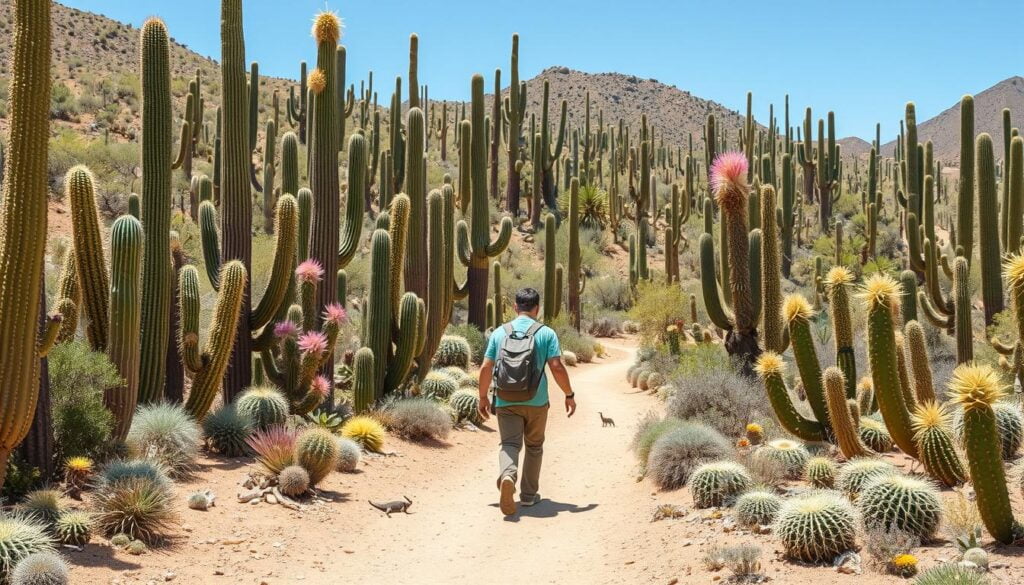
These rare cactus plants not only add beauty to your garden but also spark conversations about plant diversity and adaptability. Learning about these unique cacti helps us understand their origins and the conditions they thrive in. This knowledge is great for sustainable gardening.
Adding these lesser-known species to your garden is a choice to diversify and adapt your space. It’s about celebrating the variety of life on our planet. Whether you’re an experienced gardener or just starting with succulents and cacti, these rare plants can offer new insights into landscaping and plant care.
How to Care for Cactus Plants in Various Climates
As a cactus enthusiast, I’ve learned that successful cactus plant care is key. It’s all about knowing what these tough plants need in different climates. Whether you live in a humid or dry area, cacti can do well with the right care. Let’s look at some basic tips for taking care of cactus plants in various places.
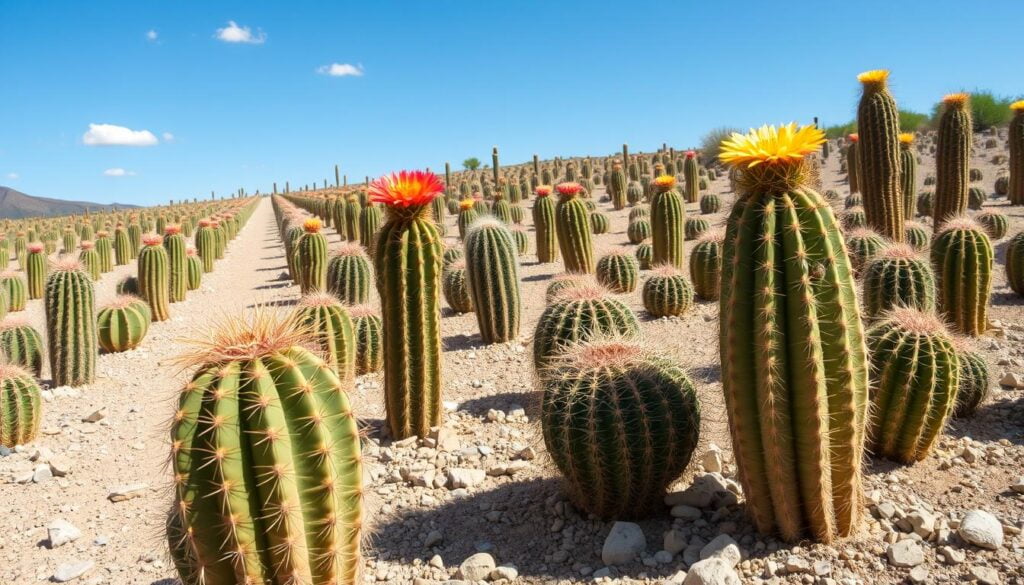
Cacti are known for being tough and easy to care for. But, they still need special care based on where they live. Here are some tips I’ve picked up over time:
- Sunlight: Most cactus species love lots of sunlight. But, in very hot places, some afternoon shade can help prevent sunburn.
- Watering: How often to water cactus depends on the climate. In dry areas, water them less often but give them more water each time. In cooler, more humid places, water them less often.
- Temperature: Cacti can handle heat, but they need protection from the cold. In cold areas, choose cacti that can handle the cold or use protection during winter.
- Soil: Good drainage is key. Make sure your cacti have well-draining soil to stop root rot, whether they’re in pots or your garden.
Changing your cactus care based on your local climate can really help them stay healthy and bloom well. Here’s a quick guide to adjust your care:
| Climate Type | Watering Frequency | Winter Care |
|---|---|---|
| Arid or Desert | Once every 2-3 weeks | Keep up with usual care as most cacti do well in dry places |
| Temperate | Adjust based on rain, usually less often | Use frost protection if it gets below freezing |
| Tropical | Watch humidity levels; water less often | No special care needed unless it gets really cold |
| Cold Winter Areas | Before the first frost, start watering less | Bring them inside or use a heat source if it’s too cold outside |
Knowing how to adjust cactus plant care for diverse climates is key. It helps keep your cacti healthy and boosts their growth and blooms. Remember, each cactus is unique and adapts in its own way to its surroundings!
Landscaping with Cactus: Striking Design Ideas
Cactus landscaping is a top choice for a low-maintenance garden. The unique shapes and sizes of cacti make them perfect for enhancing any outdoor space. Here are some design ideas to help you use these plants effectively in your landscape.
Design Idea 1: Create a Cactus Focal Point
A large, sculptural cactus can be a dramatic focal point in your garden. Place it in the center of a bed or at an entrance. It draws the eye and sets the garden’s style.
Design Idea 2: Cactus Rock Gardens
Combine different cacti with rocks to make a rock garden. This design is both beautiful and practical, needing little water. The contrast between rocks and cacti creates a stunning look.
Design Idea 3: Border Pathways with Cacti
Use small cacti or groundcover species to line pathways. They define the space and add greenery with low upkeep. This is great for guiding visitors through your garden.
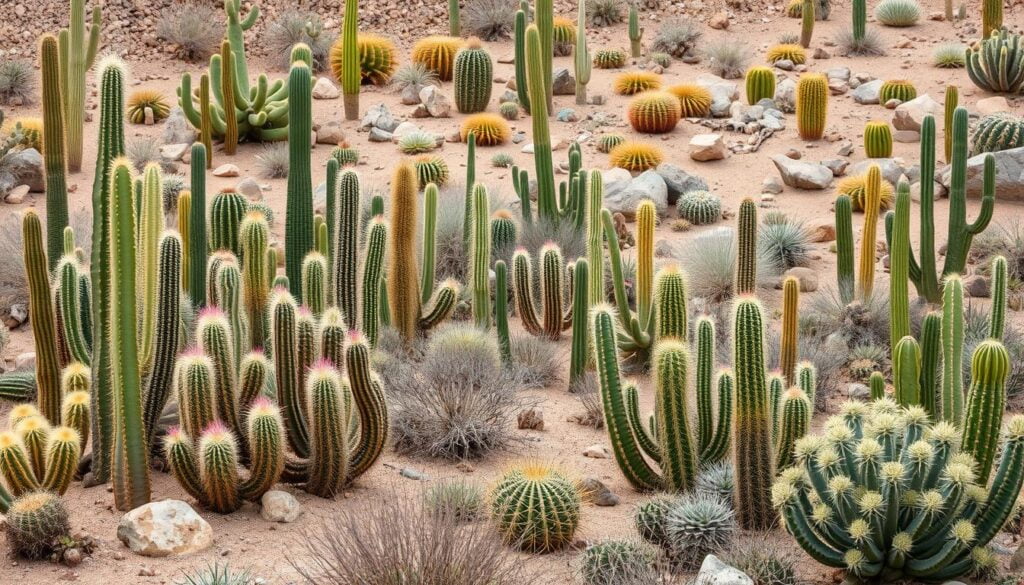
Design Idea 4: Pair Cacti with Bright Flowers
Combine the green cacti with the bright colors of flowers. The flowers will stand out against the cacti, making your landscape colorful and dynamic.
Design Idea 5: Use Cacti in Containers
Planting cacti in containers is a flexible option. You can move them around or protect them in harsh weather. This is great for those who like to change their garden’s look often.
These cactus landscaping ideas can turn your outdoor area into a stylish yet natural space. With creativity, these plants add beauty and function to any modern garden.
Combating Desertification with Cactus Planting
Desertification is a big problem in many parts of the world. Planting cacti is a key way to fight this issue. Cacti are great because they help hold the soil together and save water.

Cacti are perfect for dry places because they need little water and can handle tough conditions. Their roots keep the soil in place, which stops it from washing away. This helps other plants grow and thrive.
- The deep roots of cacti keep the soil rich and moist, helping other plants to grow.
- Adding cacti to the land makes ecosystems more sustainable, needing less water and care.
- Cactus planting benefits local wildlife by giving them shelter and food, boosting biodiversity.
In areas with bad soil, cacti can really make a difference. They not only survive but also help other plants grow. They can go without water for a long time, acting as a barrier against desertification.
“Cacti stand as natural combatants against the desert’s advance, harnessing their unique biological features to foster life even in the driest conditions.”
Planting cacti fights desertification and adds beauty and value to the land. It’s a smart way to garden in dry places, combining beauty with caring for the environment.
The Symbolism and Cultural Significance of Cacti
Cacti are more than tough plants; they hold deep cultural and spiritual meanings. They survive in harsh places and symbolize strength and resilience. These plants are important in many cultures.
Spiritual and Mythological Importance of Cacti
In many cultures, cacti are spiritual symbols. They stand for protection and the power to endure hard times. Their thick skin and water storage show how to be self-sufficient and strong.
These qualities inspire people spiritually. They teach us to stay strong in tough situations.
Cacti as a Symbol in Art and Literature
Cacti often show up in art and literature, symbolizing survival. They inspire artists and writers to explore themes like isolation and beauty in harshness. They also show how to adapt and thrive in hard conditions.
| Theme | Representation in Art | Cultural Interpretation |
|---|---|---|
| Isolation | Desert landscapes with a lone cactus | Individual strength and contemplative solitude |
| Endurance | Cacti standing resilient in storms | Ability to withstand trials |
| Adaptability | Cacti thriving in various colored media | Innovation and versatility in adverse conditions |
The cactus symbolizes deep spiritual connections and meanings across cultures. It appears in art and literature, showing survival and adaptability. This makes the cactus a powerful symbol.
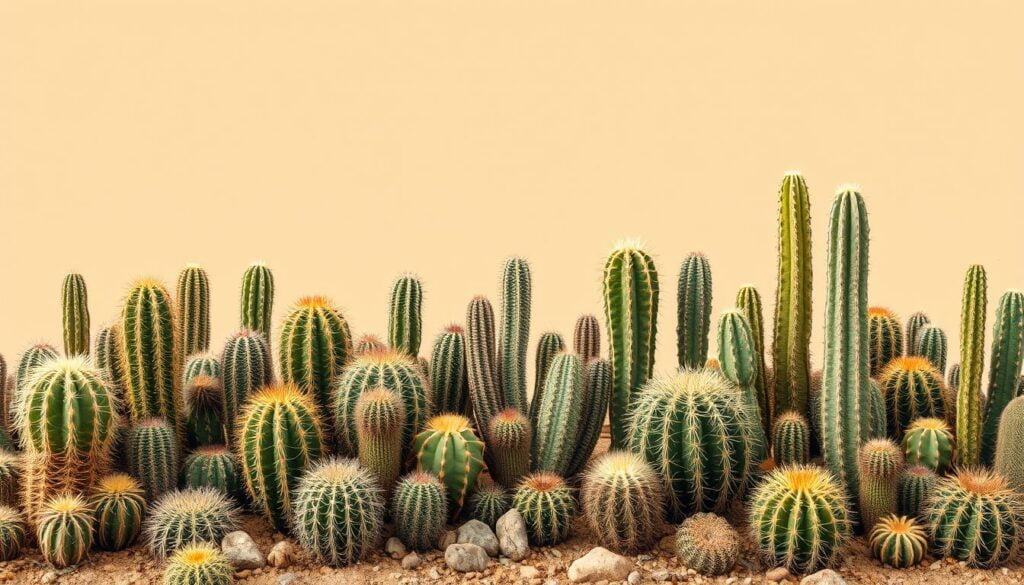
Top Picks: Exceptional Cactus Plants for Beginners
Starting with cactus plants can be fun, especially if you pick ones that are easy to care for. I’ll show you some great choices for both indoor and outdoor spaces. These plants make your first time with cacti rewarding and easy.
Easy-to-Maintain Cacti for First-Time Plant Owners
Choosing low-maintenance cacti makes gardening fun. They’re perfect for busy people or those new to gardening. The Golden Barrel, Bishop’s Cap, and Prickly Pear are great examples. They need little water and can grow in various light conditions.
Selecting Cacti That Require Minimal Attention
For beginners, picking the right cacti is key. Look for plants that look good and are easy to care for. Aloe Vera is great because it’s tough if you forget to water it. The Christmas Cactus also needs little care but brings beautiful flowers.
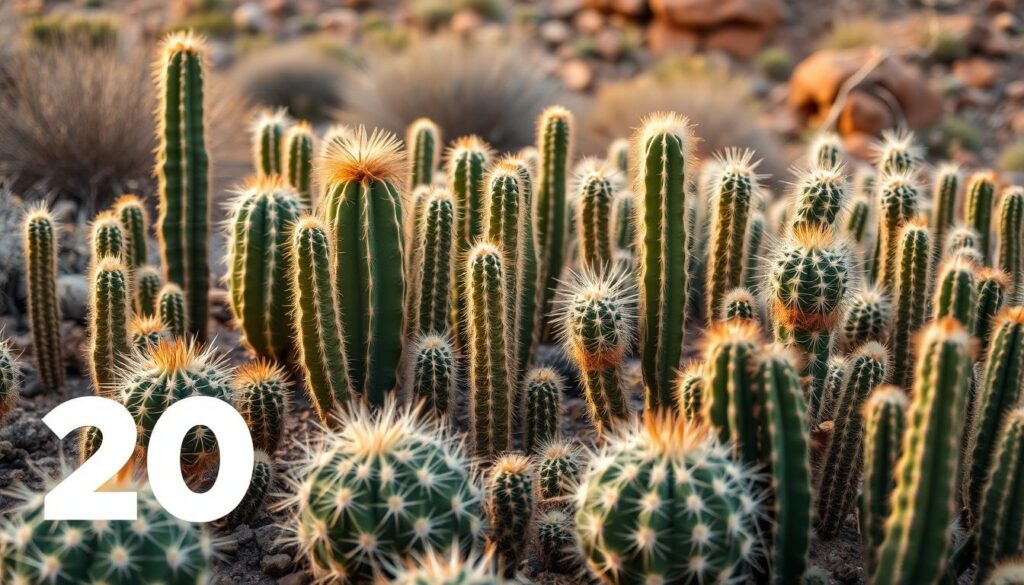
Adding drought-tolerant cacti to your garden is easy and good for the planet. These plants are ideal for gardeners who want to help the environment. They add beauty and are easy to maintain.
Don’t be scared to try cacti. With the right plants, even beginners can have a beautiful garden. Whether it’s a small indoor spot or a big backyard, starting with these easy plants will help you succeed.
Conclusion
As we end our look into cactus desert plants, we see their lasting charm goes beyond their tough look. These plants have a beauty that draws people in, connecting us to nature. They show us strength and adaptability, reminding us of our own potential.
We’ve looked at cacti from different angles—how they help with dry landscaping, their cultural value, and their wide variety. They offer something for every gardener, whether you’re just starting or adding to your plants. By growing cacti, we’re not just decorating; we’re connecting with the earth’s vast beauty.
I hope this journey has sparked your interest and prepared you for exploring cacti further. May these desert plants inspire your own space, whether indoors or outdoors. Growing cacti is about loving nature’s lasting wonders. It’s a journey full of challenges and victories in growing and learning.


